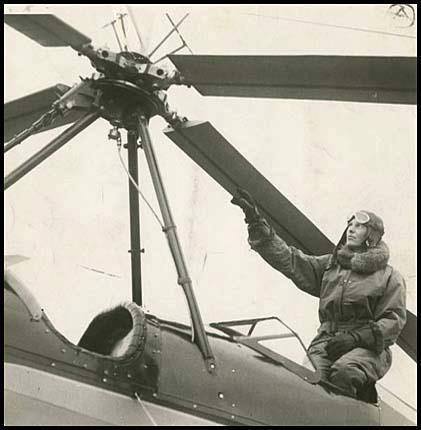
Today in Feminist History is our daily recap of the major milestones and minor advancements that shaped women’s history in the U.S.—from suffrage to Shirley Chisholm and beyond. These posts were written by, and are presented in homage to, our late staff historian and archivist, David Dismore.
Amelia Earhart added another “first” to her illustrious career today by becoming the first woman to fly an autogyro carrying a passenger.

It was only five days ago that she needed just 15 minutes of instruction to learn to pilot this “flying windmill” and become the first woman to take one up on a solo flight.
Earhart took an immediate liking to this machine, which uses a standard engine and propeller on the front for forward thrust, but instead of just two wings on the side and a tail, it also has four unpowered wings above, which rotate to provide lift as the craft moves forward through the air. This unique feature allows it to do things no other aircraft can, such as make a safe, unpowered descent from any altitude.
After five successful flights, accompanied on each by a member of the press, Earhart stopped only because it was getting dark. She then told the aircraft’s designer, Harold F. Pitcairn: “The amazing features of stability and safety will be the most important factors in bringing women into active aviation because of the added ease of control and security.” The craft’s two regular test pilots watched from below, then pronounced her handling of the machine “perfect.”
Amelia Earhart is best-known for being the first woman to cross the Atlantic in an airplane, which she did as a passenger on a 20 hour, 40 minute flight from Newfoundland to Wales beginning on June 17, 1928. She and the crew got a ticker tape parade, and a visit with President Coolidge after their arrival back in the U.S. But she is determined to become the first woman––and second person––to fly the North Atlantic by herself, though presumably in a more traditional aircraft than the one she used today.
Her career in aviation began almost exactly 10 years ago, when she took her first flying lesson from Anita Snook on January 3, 1921. That summer she bought a second-hand, two-seat yellow biplane which, of course, she called the “Canary.” On October 22, 1922 she used it to set an altitude record for women of 14,000 feet. Just months after her transatlantic flight in 1928, she became the first woman to fly solo across the U.S.
In 1929, she placed third in the first Women’s Air Derby, flying from Santa Monica, California to Cleveland, Ohio. She and several other female pilots boycotted this year’s race because of restrictions on the size of engines that women pilots would be allowed to use, and other double standards. She has upgraded to a Lockheed-Vega monoplane with a 425-horsepower Wasp engine.
This has been an active year for her, as she set the women’s speed record for a 100-kilometer course on June 25th, and another one of 181.19 miles an hour over a 3-kilometer course just 10 days later. In October she received her Commercial Air Transport License, and was also instrumental in organizing the “Ninety-Nines,” a new organization for women pilots, on November 2nd of last year.
When she’s not flying, she’s writing about it as a regular contributor to William Randolph Hearst’s “Cosmopolitan” magazine. In July, 1929, she wrote an article entitled, “Why Are Women Afraid To Fly?” and noted that girls as well as boys are fascinated by airplanes. But the girls are discouraged from taking classes that involve electrical or mechanical skills, and shunted into cooking and sewing classes, while boys are encouraged to learn the kinds of things that will prepare them for a career in aviation. Among her most recent articles was one in which she interviewed Anne Morrow Lindbergh, a skilled pilot in her own right, as well as wife of the legendary Charles Lindbergh, the first to solo across the Atlantic in 1927.
In the 27 years since the Wright Brothers made their first flight, heavier-than-air craft have proven themselves quite practical, and aviation has become an exciting field open to both men and women. Amelia Earhart’s adventures are eagerly followed by the public, and are having the desired effect of showing that women can be pilots as well as passengers.





